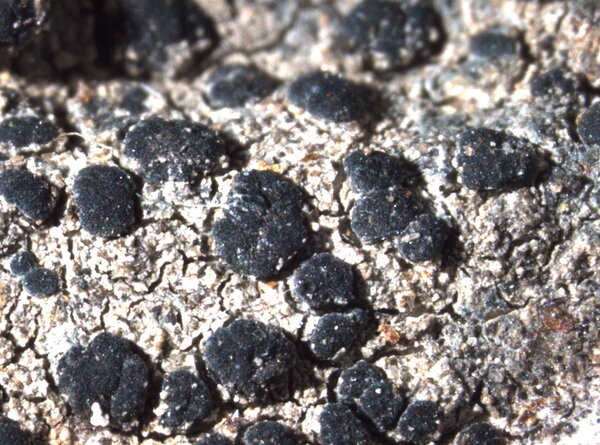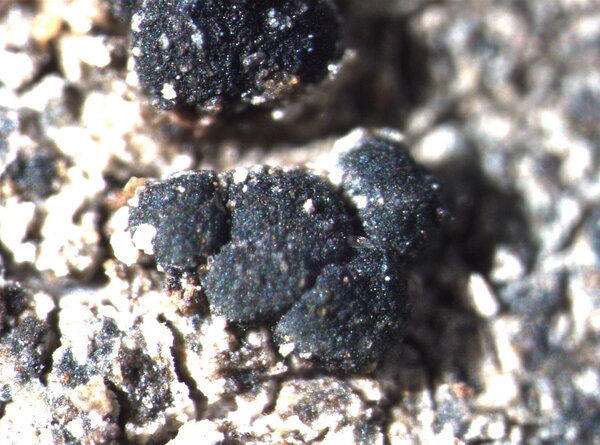Brianaria tuberculata (Sommerf.) S. Ekman & M. Svenss.
Lichenologist, 46: 292, 2014. Basionym: Lecidea tuberculata Sommerf. - Suppl. Fl. Lapp.: 160, 1826.
Synonyms: Lecidea botryocarpa Nyl.; Lecidea latens Taylor; Lecidea subinfidula Nyl.; Micarea tuberculata (Sommerf.) R.A. Anderson
Distribution: N - TAA (Nascimbene & al. 2007b, 2022).
Description: Thallus crustose, episubstratic, yellowish brown, greenish grey or greenish white, rimose and sometimes irregularly cracked and almost areolate, mostly finely granulose. Apothecia micareoid, sessile, not constricted at base, 0.15-0.3 mm across, sometimes confluent and forming up to 0.6 mm wide, tuberculate aggregates, with a convex-hemispherical, black to bluish black disc, from the beginning without a distinct proper margin. Proper exciple absent; epithecium colourless or greenish, K-, N+ red; hymenium blue-green, often with dark aeruginose-black vertical streaks, 30-40 μm high, K+ intensifying; paraphyses scarce, of two types: the majority sparingly branched and 0.5-1.5 μm thick (to 1.8 μm thick in the apical part), the others simple, often fasciculate, and (1.5-)2-3.5 μm thick, with globose, up to 4.5 μm wide terminal cells; hypothecium dark green and N+ red in upper part, olive-black in lower part, of interwoven hyphae, 80-120 μm high. Asci 8-spored, cylindrical-clavate, the I+ blue tholus with a wide, I+ dark blue tube structure that expands towards the top, without a pale axial body, Psora-type. Ascospores 1-celled or 1-septate, hyaline, oblong-ovoid or oblong-ellipsoid, thin-walled, 5.5-8(-9) x (1.3-)1.5-2.2.(-2.5) µm. Pycnidia to 0.2 mm across, immersed, the wall dark green, K+ intensifying. Conidia bacilliform, 3-4.5 x 1.1-1.4(-1.8) μm. Photobiont chlorococcoid, thin-walled, the cells globose and (5-)8-12 µm wide, or ellipsoid and up to 15 x 10 µm. Spot tests: K-, C-, KC-, P-, UV-. Chemistry: thallus without lichen substances.Note: on siliceous rocks in humid forests, but also on exposed roots, in rain-sheltered situations; reported from Trentino-Alto Adige but perhaps more widespread in the Italian Alps.
Growth form: Crustose
Photobiont: green algae other than Trentepohlia
Reproductive strategy: mainly sexual
In underhangs rarely wetted by rain
Commonnes-rarity: (info)
Alpine belt: extremely rare
Subalpine belt: very rare
Oromediterranean belt: absent
Montane belt: very rare
Submediterranean belt: extremely rare
Padanian area: absent
Humid submediterranean belt: absent
Humid mediterranean belt: absent
Dry mediterranean belt: absent

Predictive model
Growth form: Crustose
Photobiont: green algae other than Trentepohlia
Reproductive strategy: mainly sexual
In underhangs rarely wetted by rain
Commonnes-rarity: (info)
Alpine belt: extremely rare
Subalpine belt: very rare
Oromediterranean belt: absent
Montane belt: very rare
Submediterranean belt: extremely rare
Padanian area: absent
Humid submediterranean belt: absent
Humid mediterranean belt: absent
Dry mediterranean belt: absent

Predictive model
 Index Fungorum
Index Fungorum
 GBIF
GBIF




